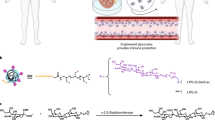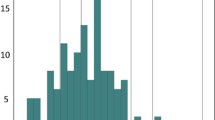Abstract
Donor kidneys were preserved in a Collins-4 solution containing periodate in concentrations of 10−2 and 10−4 mole/l, respectively, in an attempt to oxidize the carbohydrate components of the antigen-carrying membrane surfaces and thus to influence the rejection phenomena exhibited by the allogeneic kidney. All kidneys were, however, rejected as a result of a hyperacute reaction indicating that periodate did not react with the hydrophobic membrane structuresin vivo. Not only did the antigen thus remain unchanged but the vulnerability of other renal structures to the destructive effect of the killer cells also increased as a result of toxic damage.
Similar content being viewed by others
References
Edidin, M.: The tissue distribution and cellular location of transplantation antigens. In: Kahan, B. D., Reisfeld, R. A. (Eds): Transplantation Antigens. Academic Press, New York-London 1972, p. 125.
Parker, J. W., O'Brien, R. L., Lukes, R. J., Steiner, J., Paolilli, P.: Periodate induced lymphocyte transformation. I. Inhibition by sulfhydryl reducing agents and sugars.Immunol. Commun., 1, 263 (1972).
Reisfeld, R. A., Pellegrino, M. A.: Salt extraction of soluble HL-A antigens. In: Kahan, B. D., Reisfeld, R. A. (Eds): Transplantation Antigens. Academic Press, New York-London 1972, p. 259.
Romhányi, Gy., Deák, Gy., Fischer, J.: Aldehyde bisulfite-toluidine blue (ABT) staining as a topo-optical reaction for demonstration in linear order of vicinal OH-groups in biological structures.Histochemistry, 43, 333 (1975).
Rőth, E., Szmolenszky, T., Török, B.: Description and interpretation of functional changes in canine kidneys after preservation with hypothermic perfusates and subsequent reperfusion.Int. Urol. Nephrol., 10, 335 (1978).
Török, B., Rőth, E., Szmolenszky, T., Tóth, I., Halmágyi, Gy., Lantos, J.: Description and interpretation of the features of donor kidneys. I. Morphology of well-preserved kidneys.Acta Chir. Acad. Sci. Hung. (In press.)
Török, B., Rőth, E., Szmolenszky, T.: Description and interpretation of the features of donor kidneys. II. Structural and functional changes in the early stage of revascularization.Acta Chir. Acad. Sci. Hung. (In press.)
Török, B., Tóth, I., Halmágyi, Gy., Rőth, E.: Description and interpretation of the features of donor kidneys. III. Angicarchitecture and function of renal autografts.Acta Chir. Acad. Sci. Hung. (In press.)
Author information
Authors and Affiliations
Rights and permissions
About this article
Cite this article
Török, B., Rőth, E., Tóth, I. et al. Study of factors affecting the antigen structure of the donor kidney. International Urology and Nephrology 11, 215–222 (1979). https://doi.org/10.1007/BF02081962
Received:
Issue Date:
DOI: https://doi.org/10.1007/BF02081962




